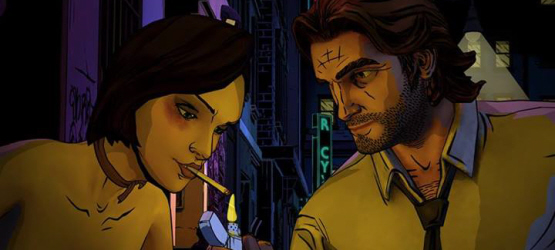Fables has been a long-running (and excellent) series under DC’s Vertigo imprint for over 10 years. Telltale Games has, in a similar fashion to Telltale’s previous The Walking Dead, taken another comic book and brought it to life before our very gaming eyes. The Wolf Among Us introduces players to the Fables community, a group of fairy tale characters who have fled to our world from a place called the Homelands. The protagonist of The Wolf Among Us is Sheriff Bigby Wolf, whose name should tell players all there is to know about his particular backstory.
The Wolf Among Us is a murder mystery. A lawman breaks up a disturbance, arguably saves a damsel in distress, and later on said damsel is found dead. The rest of the story is finding out who killed the woman and why.
What separates The Wolf Among Us is its setting. Players are treated to a New York set in the late 80s to early 90s, and for fans of the comics, prior to the events of the series. This setting means a fresh slate for everyone, and enjoyment of the Fables comic is not necessary to play The Wolf Among Us. However, modern conveniences such as cell phones and reliable internet access are not present, so the story does not rely on any of the forensic gimmicks found in much of today’s crime media. Instead, players must look at objects and ask the right questions to move forward in the plot. And there’s the whole matter of some Fables not looking like humans.
Nonhuman Fables are treated as regular characters for the most part. Aside from availing the player to a more fantasy version of New York, the nonhuman Fables also provide a different perspective on the crimes and what happened. Knowing any Fable’s name or recognizing one from their appearance can give away clues to what’s going on or what may happen. Nonhuman Fables change this around a bit, since it might not be readily apparent which set of stories one belongs.
The story is spread out among five chapters, so it may be some time before the hints garnered by Bigby pay off. But even within this first episode motifs begin to appear which impact events already in motion. It’s rather well done. Hints for the future are here, and Fables which appear in chapter one lay groundwork for which Fables may appear later.
The Wolf Among Us is also a story about choices and morals. As with previous Telltale Games releases, The Wolf Among Us is fraught with decisions about how to approach characters or which events to tackle first. Characters treated badly will remember the treatment later and act accordingly, and vice versa. Of course, the decisions are not limited to one chapter and are promised to affect later chapters. Moreover, each decision made by the player is recounted at the end of the chapter and is compared against everyone else who has played. This allows players to see what other people chose. The option to go back and do something different is available, and such a design ups the replay value significantly. On top of this players can make different saves to keep separate playthroughs.

All this decision making seems like it might negatively affect the characterization in The Wolf Among Us. It does not. The writing is superb and regardless of what role players take Bigby through – nice, mean, silent, understanding – each response suits both the character and situation. However, it appears as if some roles take Bigby to a dead end. For the curious, beating the game once allows players to ‘rewind’ the story and try a different angle or choose a different path.
The game has Quick Time Events, and all answers and responses are on a timer. The QTEs are a little awkward at first, but once understood are easy to beat. The timers for responses vary and players will have to read quickly at some points to ensure they want to offer their preferred responses. This adds a little more urgency to the unfolding drama and is a good choice for what is otherwise a visual novel.
Players looking for more information on the characters Bigby encounters over the course of the story merely need to hit pause and check out the log books. Profiles of all the characters Bigby has spoken to or read about are there for the player’s perusal, along with events of the past which help shape the world of The Wolf Among Us. These events are placed in the logbook as people mention them or certain actions are taken by Bigby.
Graphically, The Wolf Among Us appears to run on the same engine as The Walking Dead, though the art style is more reminiscent of the Fable artists for obvious reasons. The opening credits even incorporate some the comic’s unique framing and background art, which adds a nice touch to the presentation. However, it is a shame to see this engine used once more and still have the same graphical and sound hang-ups The Walking Dead had upon its release. The game is prone to stuttering, especially during transitions, and the sound stuttered a few times. The game does not always display the subtitles when they are turned on as well.
The Wolf Among Us is an excellent visual novel with, I’m sorry to report, a maddening cliffhanger for episode 2. It is easy to get hooked on the story and characters just on the couple of hours spent with them, with the graphical and sound glitches marring an otherwise great game. I heavily enjoyed myself, and still recommend it to anyone looking for a good story to entertain themselves with for a couple of hours.
-
Excellent storytelling and presentation
-
Hours pass by quickly, and leave players wanting more.
-
Excellent replay value
-
Sound and graphical glitches cause hiccups








